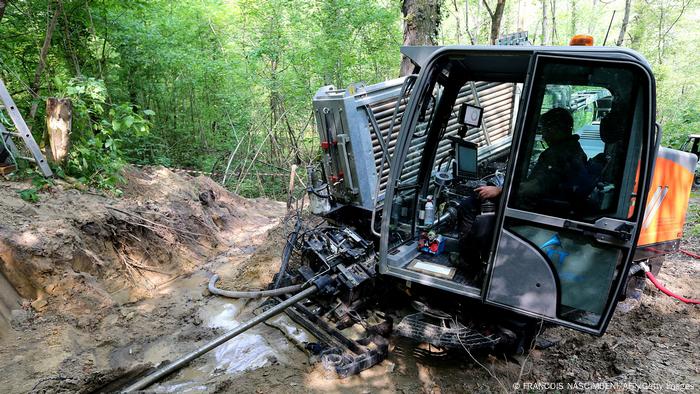An exhibition about German WWI soldiers killed in a collapsed tunnel in France traces their fate more than 100 years later. Authorities are debating on what should happen with the area.

Remembering the collapse: One of the exhibits of the Winterberg Tunnel exhibition
The exhibition "Death in the Winterberg Tunnel. A Tragedy in World War I" tells about the fate of hundreds of German soldiers who were buried alive in a protective tunnel in northern France, in May 1917.
The exact number of soldiers who died there remains unclear. The exhibition, at Germany's General State Archives of Baden-Württemberg in Karlsruhe, notes "about 100 to 150 soldiers," while some historians have found there were between 250 and 270. There has even been speculation that 400 people went missing.
'Insane chaos'
"Today, we assume that 80 to 100 soldiers were in the tunnel and about 100 were in the immediate vicinity," Diane Tempel-Bornett, a spokeswoman for the German War Graves Commission, told DW.
She mentions the account of a soldier who managed to get out after two days, and who described the situation as "insane chaos," as "artillery fire caused the ammunition stored at the entrance to explode, tracer ammunition also caught fire and toxic gases developed."
Founded in 1919, the German War Graves Commission has contributed to the exhibition with some of their excavation finds.
The commission is "dedicated to the task of recording, preserving and caring for the graves of German war dead abroad on behalf of the German government," as their website states.
Financed mainly by donations, it currently looks after "more than 830 war cemeteries and graves in 46 countries, the last resting places of about 2.8 million war casualties." The commission also helps relatives search for graves, and offers guided tours of war cemeteries to schoolchildren.
Fate of millions of soldiers unknown
The buried soldiers belonged to Baden Reserve Infantry Regiment 111, and the tunnel at Winterberg in the small French commune of Craonne in the Aisne department served as a link between their trenches. Only three soldiers survived; the bodies of the others were never recovered. The site of the incident was never rediscovered.

Trying to find the entrance to the tunnel in May 2022
Winterberg Tunnel was forgotten for a long time, which is not unusual — the fate of millions of soldiers who fought in the world wars remains unresolved worldwide.
More than 100 years after the tunnel collapsed, there is still no consensus on how the area and the buried soldiers' remains should be handled.
In recent years, investigations have picked up steam. Amateur archaeologists, too, have tried their hand at illegal excavations.
"These sites draw amateur historians, at worst grave robbers," says Tempel-Bornett, adding that unfortunately, they can also destroy clues and traces.
Today, the area is a nature reserve, overgrown and forested. It is also a restricted zone — ammunition was found there last year.
The tunnel, where the soldiers' remains are presumed buried, is dozens of meters underground. The exact location of the grave is unclear, and complex drilling and seismographic investigations have recently shown the conditions to be difficult.
Safeguard eternal rest
"The War Graves Commission works with the French authorities and always with their authorization," says Tempel-Bornett. When working in the previously secured areas they are allowed to access, they are "accompanied by the fire department, explosives experts, the gendarmerie, representatives of the authorities and the forestry department." An ambulance always stands by, too.
Meanwhile, the Franco-German Council of Ministers is debating whether the remains should be recovered — which is not even the association's main interest, says Tempel-Bornett.
"Our task is to ensure that the peace of the dead is guaranteed," the spokeswoman says, as well as preventing unauthorized persons from digging at the site and disturbing the peace of the dead, perhaps looting graves, and putting themselves in danger.
Winterberg could also become an official memorial site. "Many can't bear the uncertainty of what happened to their ancestors," says Tempel-Bornett, adding it can give relatives a sense of peace when, for instance, their grandfather's name appears on a memorial plaque at the Rossoshka war cemetery in Volgograd, formerly Stalingrad.
Others need a place to grieve, she says, recalling octogenarians standing at the graves of fathers they last saw when they were children. "Tears are shed, but it helps them come to terms with the past."

The German War Graves Commission has set up a provisional memorial
The association has dark chapters in its own past. Founded by soldiers, it was highly respected by the Nazis.
According to a 2019 study, the association long had problems distinguishing between perpetrators and victims and not turning the commemoration of fallen soldiers into heroes' memorials.
The debate over burials
In view of the role of German soldiers as aggressors in the world wars, the War Graves Commission must always justify its commemorations — that is also true for the Winterberg tunnel.
War criminals, she says, must be buried, too. "That is criticized sometimes, but it's ingrained in our Christian culture that everyone should have a grave."
The exhibition in Karlsruhe aims to recreate the tunnel look with a three-dimensional exhibition architecture. Various excavation finds from the tunnel made available by the War Graves Commission are on public display for the first time.
"Death in the Winterberg Tunnel. A Tragedy in World War I" is on show at the Generallandesarchiv Karlsruhe until August 14, 2022, before moving on to France and Belgium as a traveling exhibition.
This article was originally written in German.
No comments:
Post a Comment